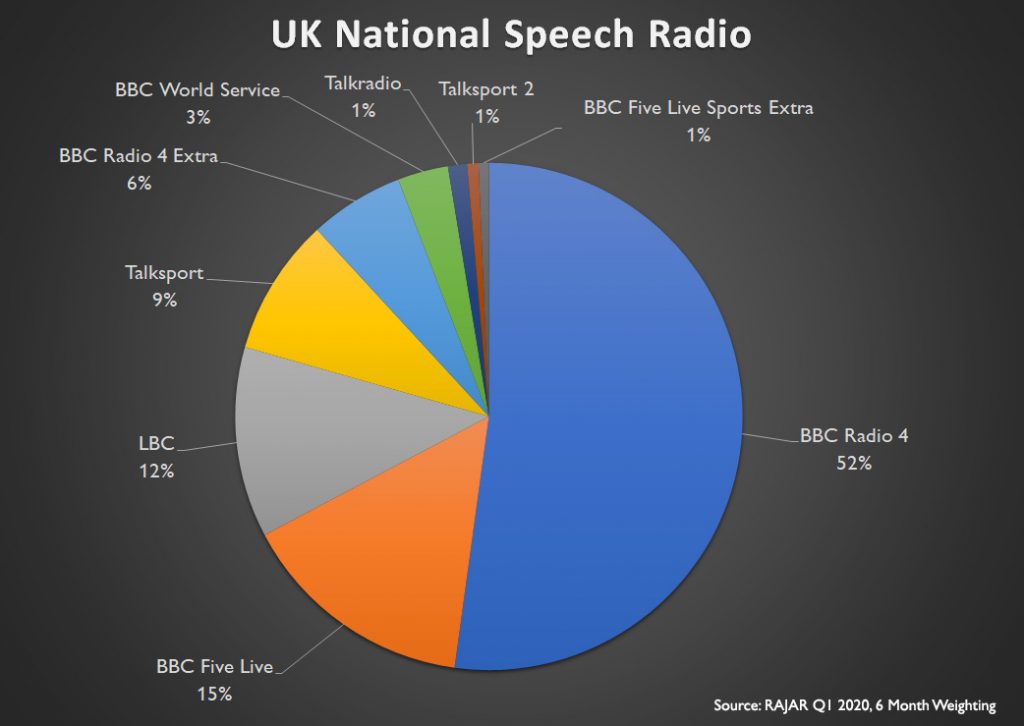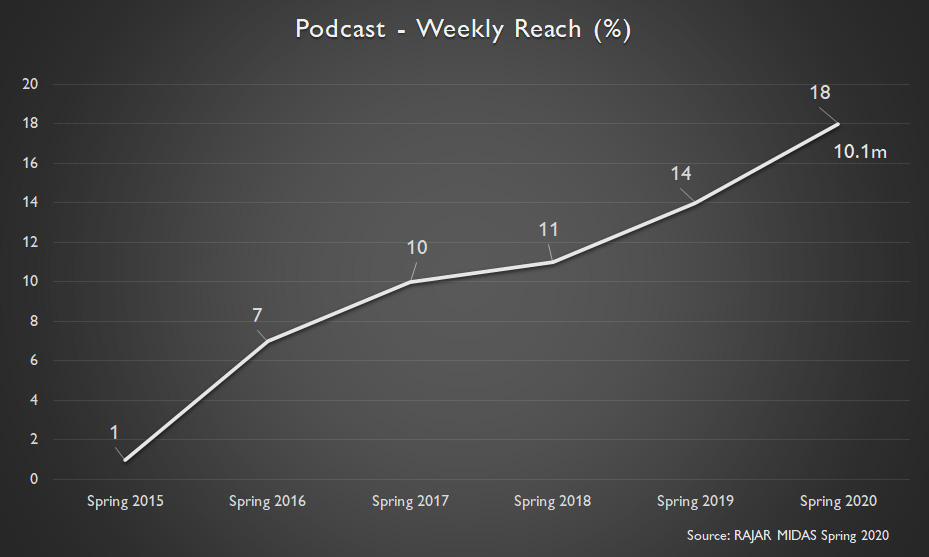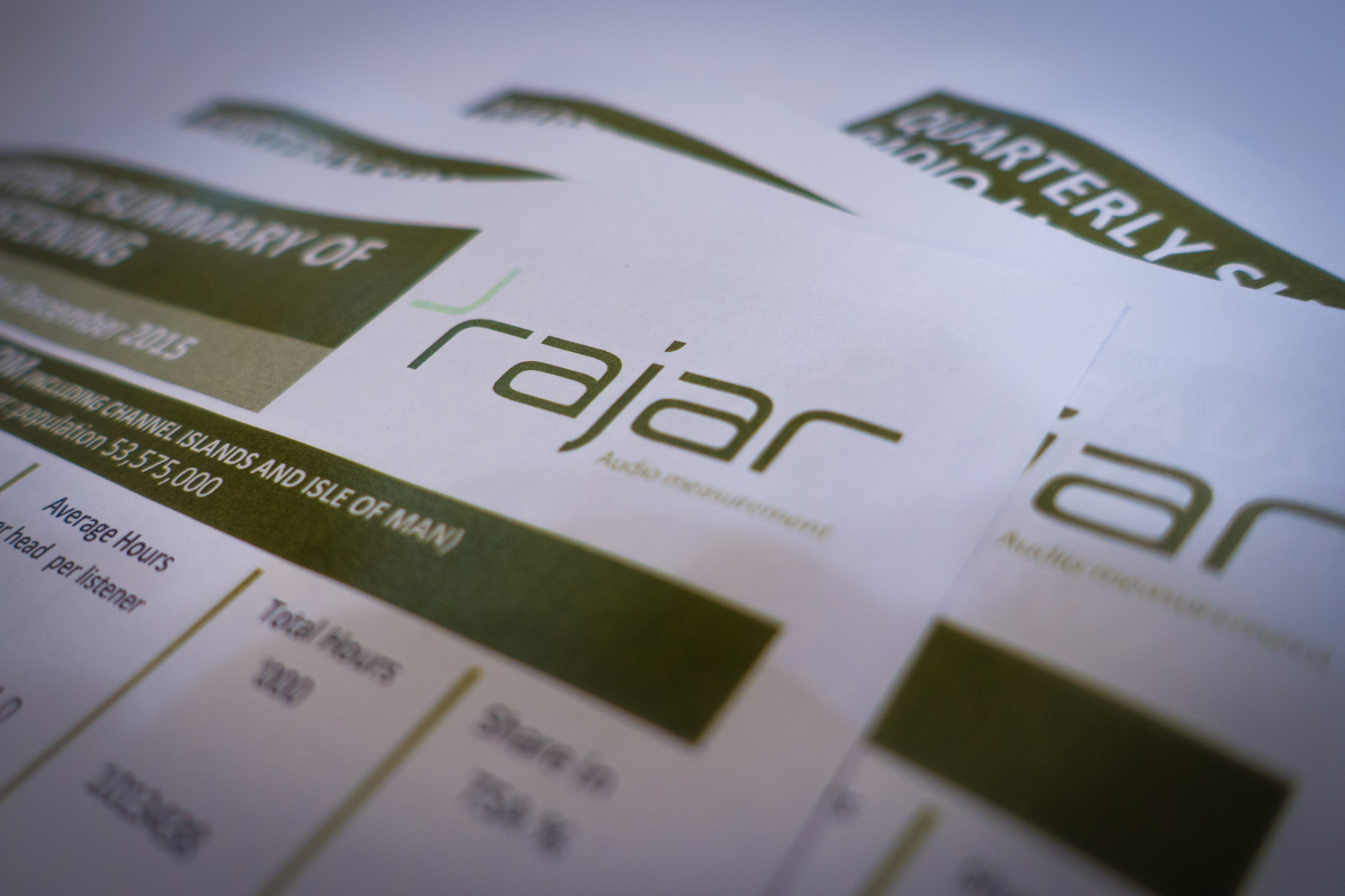This post is brought to you in association with RALF from DP Software and Services. I’ve used RALF for the many years, and it’s my favourite RAJAR analysis tool. So I am delighted that I continue to be able to bring you this RAJAR analysis in association with RALF. For more details on the product, contact Deryck Pritchard via this link or phone 07545 425677.
There may be a global pandemic occupying our every thought, but there is still RAJAR. It’s worth noting that most of the fieldwork for this quarter’s RAJAR was conducted prior to lockdown. So this set of data won’t definitively be able to say what effect so many people staying at home has had on radio listening now that so many of us don’t have a commute in the morning, or even jobs. And it seems likely that overall media consumption patterns will have changed somewhat.
Read RAJAR’s full statement on their website on what the lockdown has meant for RAJAR data.
Ordinarily, RAJAR data is collected over the entirety of a quarter, with roughly similar numbers of respondents each week. This RAJAR period ran through to the 29th March 2020, while the Prime Minister announced the lockdown on the 23rd March. So very little post-lockdown data will appear in this set of results.
In normal times, people are recruited to RAJAR via door-to-door visits, even if they subsequently fill out their diaries online. RAJAR hasn’t publicly said how they’re measuring for Q2 2020, but I would expect that they’re recruiting either by phone, or perhaps online. Either way, the Q2 2020 results will be very interesting, and may pose issues about making direct comparisons with previous waves of RAJAR. Note that things will potentially get much more complicated for the majority of local stations that don’t report their data with quarterly weighting. It’s mostly only larger national and London stations that use quarterly weighting.
Listening Trends
In overall terms, radio listening is up on the previous quarter, but down on last year.
Reach is up to nearly 49m (up 1.6% on the quarter and down 0.1% on the year), while hours have climbed back to 988m, up 1.2% on the quarter, although still down 3.4% on the year when it was still over a billion.
Commercial radio is trending better than the BBC. Reach was up 3.2% on the quarter and up 0.4% on the year to 36.2m, while hours grew 3.8% on the quarter and 0.9% on the year to 472m.
At a time when just about every advertising-based business is suffering, these growth figures will be very important for the sector.
BBC Radio overall is down 0.1% on the quarter and down 2.6% on the year in reach, with 33.5m listeners. Hours are down 1.2% on the quarter and down 6.6% on the year to 491m.
For what it’s worth, the average commercial radio listener is aged 46, while the average BBC listener is aged 50.
75% of radio listeners hear at least some radio via a Digital Platform, with the percentage of Digital Listening now at 58.6%.
Listening amongst 15-24s, actually climbed a little this quarter. 82% of 15-24s listen to the radio, up from 78% just a quarter ago. They represent around 8.0% of all listening, although this was closer to 9.0% three years ago.
Speech
Last quarter, speech radio did very well in a period when there was a General Election. As I write this, we’re now in an even more intensive news period, but as I outlined above, the pandemic only really captures the tail end of this RAJAR period and so is not truly measured here, at least regarding its impact in the UK.
Radio 4 fell back from last quarter’s gains, down 2.0% on the quarter and down 2.3% to 10.8m. Hours fell 1.8% on the quarter and were down 5.0% on the year to 115.2m.
Those numbers are similarly reflected in the Today Programme’s Monday-Friday performance. Reach was down 2.7% on the quarter and down 2.6% on the year to 7.0m.
Across at Five Live, reach fell 3.6% on the quarter and 3.4% on the year to 5.2m. Hours were down 4.1% on the quarter and 6.6% on the year to 32.8m.
Five Live Breakfast was also down 3.6% on the quarter and down 2.0% on the year to 1.8m.
[As an aside, I personally think the Five Live breakfast show right now is exceptional].On the other hand the LBC Brand (renamed from LBC Network this quarter), is up 2.2% on the quarter and up a startling 23.6% on the year to 2.8m, while hours are up 7.9% on the quarter and up 25.2% on the year to 27.0m.
A reminder that LBC News was added to the national DAB multiplex in October last year, and the LBC Brand number combines the main station with LBC News. Only with this quarter have we been able to fully break out the main service from the rolling news service.
The rolling LBC News service is reporting a reach of 657,000, while the main station is reporting 2.4m.
The station saw growth throughout last year leading into the General Election, and has maintained that listening in the first quarter of this year. Over the LBC Brand, these are another set of record breaking reach and hours figures.
Over at Wireless, Talksport had a good set of figures on the quarter, although less so on the year. Reach was up 2.5% on the quarter and down 2.3% on the year to 3.0m. Hours were up 8.5% on the quarter but down 3.2% on the year to 19.5m.
Talksport has just announced the biggest shake-up to its breakfast show for some years, with Alan Brazil handing over Monday-Wednesday presenting duties to Laura Wood. That only happened recently, so isn’t reflected here. (Also, there was actual sport being played during this quarter!)
Talksport 2 had the commentary rights to the England cricket tour this winter, so their numbers get a massive injection off the back of it. Reach was up 50.9% on the quarter (and 15.3% on the year) to 489,000. Hours were up 99.4% on the quarter (and up 8.5% on the year) to 1.6m.
Talkradio had mostly positive numbers, with reach down 2.1% on the quarter but up 25.1% on the year to 424,000. Hours were up 7.9% on the quarter and up 97.3% on the year to 2.7m.
Of course, the big news in speech radio is Wireless’ upcoming launch of Times Radio. We don’t know exactly when it’ll be launching yet – we’re told it will be “this summer” – but they’ve been busy hiring staff, particularly from the BBC. Quite how it carves out a space in the speech radio landscape will be interesting.
You should definitely read Matt’s piece on Times Radio if you haven’t already.
In total, I calculate that national speech radio stations currently account for around 18.4m listeners and 222m hours. If we see how that listening is divided up, we get the following:

Times Radio will either need to grow this market – find people who are not listening to speech radio already – or shift some of that listening from these other stations into their station.
By the way, while this chart accounts for 222m hours, the rest of radio listening accounts for 770m hours. If we generally call that “music” radio, you can see that it accounts for around 3.5 times as much radio as speech.
(NB. I am well aware that many of those stations I’ve dubbed “music” radio – especially BBC Local Radio stations – have significant quantities of speech as well as music).
It’s also worth saying that all speech radio is not the same. After all, Radio 3 and Kiss are both music stations, but they’re remarkably different otherwise!
While speech radio is an exciting opportunity – last week came news that Bauer is closing Liverpool’s Radio City Talk.
Finally, RAJAR published the Spring 2020 MIDAS report recently, measuring internet delivered audio. One key slide in the report is the continued growth in podcasts, which tend to be speech based.
Copyrighted music and podcasts is a nightmarish area – don’t go there!

The chart above shows the continued growth of podcasting in the UK, up by four percentage points in the last year. That’s 10.1m people listening speech audio that is not captured in the regular RAJAR survey.
National Stations
Radio 1 has delivered decent numbers compared with last quarter, but was down on the year. Reach was up 1.4% on the quarter (down 4.2% on the year) to 8.9m. Hours were up 1.2% on the quarter (down 5.3% on the year) to 55.7m.
Greg James (when he was doing his usual hours, and based on Monday to Friday) was up 0.7% on the quarter, but down 2.2% on the year to 5.2m – so performing slightly better than the station overall.
Radio 2 was down 0.5% on the quarter and down 6.5% on the year, for a total reach of 14.4m. Hours were down 2.9% on the quarter and down 9.2% on the year.
Zoe Ball’s breakfast show was down 1.5% on the quarter and down 10.3% on the year to 8.1m. Although a reminder that Ken Bruce actually has the biggest show on the station in his mid-morning slot. He was down 0.6% on the quarter and down 6.7% on the year to 8.2m.
6 Music had a good quarter, with reach up 2.8% on the quarter and up 1.6% on the year to 2.6m. Hours were up 1.2% on the quarter, but down 5.5% on the year to 23.5m.
Radio 3 continues to bounce around. This quarter it lost 6.9% on the quarter and was down 2.9% on the year in reach to 2.0m. Hours fell 6.2% on the quarter but rose 7.2% on the year to 13.2m.
So where were commercial radio’s gains? That’s a good question.
The overall Capital Brand (i.e. All the Capitals across the country and Capital XTRA) was down in reach 1.2% on the quarter and down 9.1% on the year to 7.5m. Hours were down 6.5% on the quarter and down 15.9% on the year to 36.6m. Those latter numbers in particular will be of concern in Leicester Square.
The Capital Network was down 2.4% on the quarter and down 12.1% on the year to 6.4m. Hours fell 7.9% on the quarter and fell 17.6% on the year to 29.8m.
Capital XTRA at least saw a rise on the quarter in reach, up 0.8%, but down 5.7% on the year to 1.7m. Hours fell 8.1% on the quarter and were down 22.3% on the year to 5.6m.
Over at sister Global brand Heart, the story is similar.
The overall Heart Brand was down 1.7% on the quarter and down 3.9% on the year to 9.4m reach. Hours fell 3.8% on the quarter and 11.3% on the year to 58.3m.
The main Heart Network saw reach fall 4.2% on the quarter and 9.4% on the year to 7.7m. Hours fell 6.7% on the quarter and 18.0% on the year to 47.2m.
The newish Heart 70s was up 18.5% on the quarter to 294,000 reach (hours grew 54.7% to 1.2m). Heart 80s grew 13.9% on the quarter, but fell 12.2% on the year for a reach of 1.2m. Hours fell 3.6% on the quarter, and were down 29.6% on the year to 4.4m. Heart 90s was down substantially in both reach (down 27.3% to 456,000) and hours (down 39.4% to 1.6m). Heart Dance was flat on reach at 380,000 while hours fell 5.6% to 1.7m. And Heart Extra was down 2.3% on the quarter (up 0.4% on the year) to 472,000, and down 9.6% on the quarter (up 3.4% on the year) to 1.8m.
The Smooth Brand was up 1.4% in reach on the quarter but down 2.5% on the year to 5.7m. Hours were up 0.1% on the quarter but down 10.3% on the year to 38.6m.
Classic FM did decently, up in reach 0.4% on the quarter and up 3.7% on the year to 5.5m, with hours up 3.0% on the quarter and up 6.6% on the year.
All of this meant that Total Global Radio (UK), representing the stations they own, was up 0.6% in reach on the quarter, but down 1.1% on the year to 23.4m. Hours fell a modest 0.2% on the quarter, and a larger 3.9% on the year to 202m.
Across at Bauer, there was a mostly decent quarter for Absolute Radio. Reach grew 4.6% on the quarter, although it fell 0.3% on the year to 2.4m. Hours rose 9.7% on the quarter, but fell 9.1% on the year to 18.4m.
Absolute 80s still holds onto its lead over Heart 80s, with reach up 2.7% on the quarter, but down 16.0% on the year to 1.5m. Hours were up 1.0% on the quarter, but down 17.8% on the year to 7.1m.
Those meant that across the Absolute Radio Network as a whole reach fell 3.9% on the quarter and was 0.7% down on the year to 4.7m. Hours dropped 3.4% on the quarter and 0.5% on the year to 33.6m. (Sadly we can’t look forward to Absolute Radio 40s RAJAR figures next quarter. The station was an entertaining one-day pop-up for VE Day and won’t be measured!)
Magic has had a good quarter, up 1.5% in reach on the quarter and up 0.2% on the year to 3.3m. But hours are well up, growing 10.5% on the quarter and 10.9% on the year to 19.5m.
Across the Magic Network reach was down 2.0% on the quarter and down 3.1% on the year to 4.1m. However, hours grew 0.8% on the quarter and 2.3% on the year to 24.6m.
Kiss saw some falls, with reach down 5.4% on the quarter and down 7.0% on the year to 3.6m, while hours were down 15.7% on the quarter, and 3.1% on the year to 14.7m.
Kisstory remains sizeable despite its reach falling 6.3% on the quarter, it was up 12.0% on the year to 2.1m. Hours fell 9.2% on the quarter but were up 9.4% on the year to 8.2m.
Overall though, the Kiss Network was down 2.7% on the quarter and down 7.9% on the year to 5.1m. Hours were down 5.5% on the quarter and down 11.6% on the year to 26.5m.
The scale of the Hits Radio Brand across a multiplicity of local stations means that changes tend to be modest. Reach was down 0.6% on the quarter, but up a notable 7.4% on the year to 6.6m. Hours grew 0.5% on the quarter but fell 0.7% on the year to 52.9m.
Finally Scala Radio got a decent rise this quarter with reach growing 24.5% to 310,000 and hours up 29.5% to 2.0m. Bauer still continues to invest in the station, with TV and press ads that I’ve noticed.
Overall that means that Bauer Radio – Total (which incorporates all their stations) was down 1.0% in reach on the quarter, but up 0.3% on the year to 18.0m. Hours were down 0.8% on the quarter and down 1.2% on the year.
Note that news only came through from the Competition and Markets Authority towards the end of this RAJAR period, that Bauer would be allowed to take full control of the stations it bought from UKRD, Wireless, Lincs FM and Celador. That means that those stations’ RAJAR figures are not included in these numbers. I expect that they’ll start to be included in Bauer’s overall figures from next quarter.
Finally, Virgin Radio saw reach fall 2.2% on the quarter, but rise 15.0% on the year to 1.5m. Hours fell 9.5% on the quarter, and rose 14.9% on the year to 8.9m.
Further Reading
The official RAJAR site and their infographic
Radio Today for a digest of all the main news
Matt Deegan will have some great analysis
Media.Info for lots of numbers and charts
Mediatel’s Newsline will have lots of figures and analysis
BBC Mediacentre for BBC Radio stats and findings
Bauer Media’s corporate site
Global Radio’s corporate site
Radiocentre’s website
All my previous RAJAR analyses are here.
Matt and I did a livestream talking about RAJAR. If you really want to hear more direct from us, with questions and a special guest, here it is!
Source: RAJAR/Ipsos MORI/RSMB, period ending 29 March 2020, Adults 15+. Also of note is that I treat all weekday shows as Mon-Fri except where specified. Some presenters have Friday off, but to compare like with like, I’ve stuck with a five day week.
Disclaimer: These are my views alone and do not represent those of anyone else, including my employer. Any errors (I hope there aren’t any!) are mine alone. Drop me a note if you want clarifications on anything. Access to the RAJAR data is via RALF from DP Software as mentioned at the top of this post.

